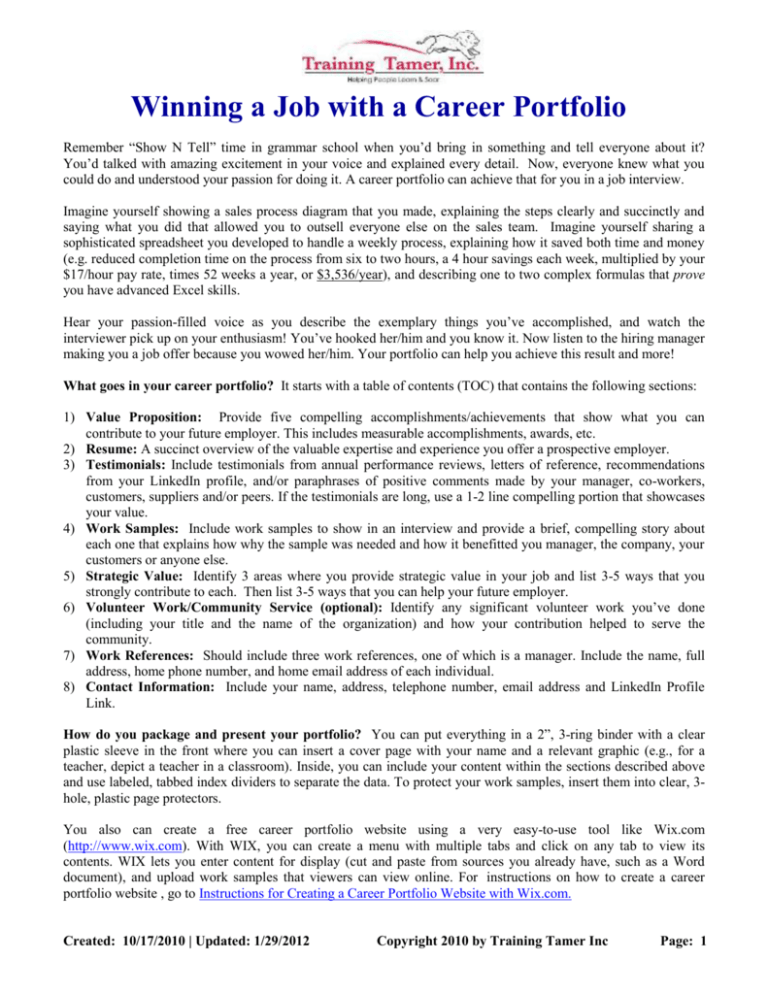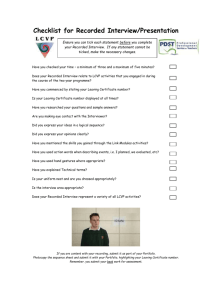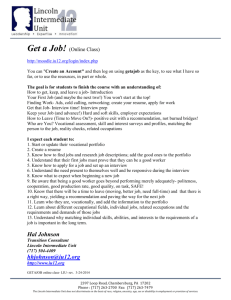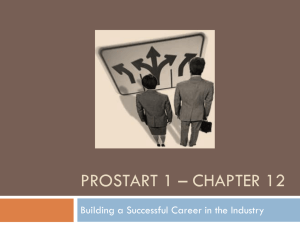- Training Tamer
advertisement

Winning a Job with a Career Portfolio Remember “Show N Tell” time in grammar school when you’d bring in something and tell everyone about it? You’d talked with amazing excitement in your voice and explained every detail. Now, everyone knew what you could do and understood your passion for doing it. A career portfolio can achieve that for you in a job interview. Imagine yourself showing a sales process diagram that you made, explaining the steps clearly and succinctly and saying what you did that allowed you to outsell everyone else on the sales team. Imagine yourself sharing a sophisticated spreadsheet you developed to handle a weekly process, explaining how it saved both time and money (e.g. reduced completion time on the process from six to two hours, a 4 hour savings each week, multiplied by your $17/hour pay rate, times 52 weeks a year, or $3,536/year), and describing one to two complex formulas that prove you have advanced Excel skills. Hear your passion-filled voice as you describe the exemplary things you’ve accomplished, and watch the interviewer pick up on your enthusiasm! You’ve hooked her/him and you know it. Now listen to the hiring manager making you a job offer because you wowed her/him. Your portfolio can help you achieve this result and more! What goes in your career portfolio? It starts with a table of contents (TOC) that contains the following sections: 1) Value Proposition: Provide five compelling accomplishments/achievements that show what you can contribute to your future employer. This includes measurable accomplishments, awards, etc. 2) Resume: A succinct overview of the valuable expertise and experience you offer a prospective employer. 3) Testimonials: Include testimonials from annual performance reviews, letters of reference, recommendations from your LinkedIn profile, and/or paraphrases of positive comments made by your manager, co-workers, customers, suppliers and/or peers. If the testimonials are long, use a 1-2 line compelling portion that showcases your value. 4) Work Samples: Include work samples to show in an interview and provide a brief, compelling story about each one that explains how why the sample was needed and how it benefitted you manager, the company, your customers or anyone else. 5) Strategic Value: Identify 3 areas where you provide strategic value in your job and list 3-5 ways that you strongly contribute to each. Then list 3-5 ways that you can help your future employer. 6) Volunteer Work/Community Service (optional): Identify any significant volunteer work you’ve done (including your title and the name of the organization) and how your contribution helped to serve the community. 7) Work References: Should include three work references, one of which is a manager. Include the name, full address, home phone number, and home email address of each individual. 8) Contact Information: Include your name, address, telephone number, email address and LinkedIn Profile Link. How do you package and present your portfolio? You can put everything in a 2”, 3-ring binder with a clear plastic sleeve in the front where you can insert a cover page with your name and a relevant graphic (e.g., for a teacher, depict a teacher in a classroom). Inside, you can include your content within the sections described above and use labeled, tabbed index dividers to separate the data. To protect your work samples, insert them into clear, 3hole, plastic page protectors. You also can create a free career portfolio website using a very easy-to-use tool like Wix.com (http://www.wix.com). With WIX, you can create a menu with multiple tabs and click on any tab to view its contents. WIX lets you enter content for display (cut and paste from sources you already have, such as a Word document), and upload work samples that viewers can view online. For instructions on how to create a career portfolio website , go to Instructions for Creating a Career Portfolio Website with Wix.com. Created: 10/17/2010 | Updated: 1/29/2012 Copyright 2010 by Training Tamer Inc Page: 1 After you build your career portfolio website, you’ll be given the website address so you can include this link in your cover letter, resume, LinkedIn profile, etc. Research shows that HR staff and recruiters are more likely to click on a link to view job seeker information than they are to download an attached file providing the same data. The last option for a career portfolio is to create a comprehensive profile on LinkedIn (www.linkedin.com). This includes a short and compelling summary, your resume, and work samples you can upload and display with the SlideShare Application available with LinkedIn. With SlideShare, you can display one of your full-sized work samples, inside the SlideShare Viewer. The Viewer has buttons to let you easily page forward and backward through the file. Select your hottest work sample for this prized position. You can use both your career portfolio website and LinkedIn profile during a telephone prescreen interview to set yourself apart from the pack. When an interviewer calls you to schedule a prescreen interview, just suggest s/he be at a PC when calling back because you would like to share some key, strategic work samples. When do you show your career portfolio to interviewers? You can show it during the telephone prescreen interview and during a personal interview. When the interviewer calls you to schedule the prescreen interview, just tell him/her to be at their PC when s/he call because you want to show them some key, strategic work samples. You can also show it during in person interviews as well. And even if you’ve shown it to one person before, you might have to speak to others who have not seen it. Always be prepared to show relevant work samples to anyone you meet. What do you do if you’ve never saved work samples? You have several options. First, you can recreate a brief facsimile of one or two of your work samples. Second, you can go back to your previous employers and ask them for a couple samples you can use in your job search. If you have a work sample that contains sensitive data, such as Monthly Sales Report with customer names, customer sales totals, and the grand total of sales for the month, you need to sanitize the report to change this information but still keep it representative of the level of sales in which you were involved. Clear the final version with your previous employer(s) before sharing it. Can your career portfolio help you get a better salary? Absolutely! Work samples shared during an interview prove your value. When negotiating salary, you can remind employers of the things you shared and use those proofs evidence to support your request for a higher salary. Remember, you’ve got nothing to lose by trying! How do you ensure you have time to share your career portfolio in an interview and ask any questions? To guarantee you get the 10-15 minutes you need for this, ask the interviewer in advance to reserve that amount of time for you at the end of the interview. If you don’t state this need, the interviewer may use all the time, and you’ll lose a valuable opportunity to strut your stuff and distinguish yourself from the other candidates. This is sales; sharing your silver bullets to differentiate yourself from the pack makes all the difference in the end. I hope this information will be helpful in your job search. If you have any questions or require assistance, you can email me at larrylabelle@trainingtamer.com. Good luck! Remember that every rejection moves you closer to THE WIN: pray, pray as though everything depended on God; work, work as though it all depends on you. Words alone have limited power. But a work sample described with an enthusiastic and compelling story demonstrates your value to an employer and will help you win a job every time! Believe it! Created: 10/17/2010 | Updated: 1/29/2012 Copyright 2010 by Training Tamer Inc Page: 2









